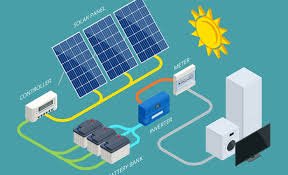Comprehensive Solar Power Solutions for Sustainable Living
As climate change continues to impact the globe, transitioning to solar power solutions has become more critical than ever.

Solar Power Solutions
In today’s world, the demand for sustainable energy has reached unprecedented levels. As climate change continues to impact the globe, transitioning to solar power solutions has become more critical than ever. This guide explores everything you need to know about solar energy, from its benefits to installation, and how it can transform your energy consumption.
What Are Solar Power Solutions?
Solar power solutions refer to systems and technologies designed to harness energy from the sun and convert it into usable electricity. These systems typically include solar panels, inverters, batteries, and other components that work together to provide clean, renewable energy.
Key components of a solar power system:
- Solar Panels: Convert sunlight into direct current (DC) electricity.
- Inverters: Transform DC electricity into alternating current (AC) for household use.
- Solar Batteries: Store excess energy for use during the night or on cloudy days.
- Monitoring Systems: Track energy production and usage.
Benefits of Using Solar Power Solutions
Adopting solar power solutions brings a host of benefits, both for individuals and the environment.
1. Cost Savings
Switching to solar energy can significantly reduce or even eliminate your electricity bills. With the right-sized system, homeowners can generate enough power to meet their needs, avoiding rising utility rates.
2. Environmental Impact
Solar energy is a clean and renewable source of power. By choosing solar, we can reduce greenhouse gas emissions, minimize our carbon footprint, and help combat climate change.
3. Energy Independence
Solar systems provide energy independence by reducing reliance on grid electricity. With solar battery storage, you can ensure uninterrupted power even during outages.
4. Increased Property Value
Homes equipped with solar panels are considered more valuable. Buyers are increasingly looking for energy-efficient properties, making solar installations a profitable investment.
Types of Solar Power Solutions
There are various types of solar power systems to suit different needs. Here’s a breakdown:
1. Grid-Tied Solar Systems
These are connected directly to the utility grid. Excess power generated is sent back to the grid, and you receive credits through a process called net metering.
2. Off-Grid Solar Systems
Ideal for remote areas, off-grid systems operate independently of the utility grid. They rely on solar batteries for storing power.
3. Hybrid Solar Systems
A combination of grid-tied and off-grid systems, hybrid setups utilize solar batteries while remaining connected to the utility grid for backup.
How to Choose the Right Solar Power Solution
1. Assess Your Energy Needs
Before installing a solar system, evaluate your household’s energy consumption. This helps determine the size and type of system required.
2. Consider Your Budget
Solar power systems can be tailored to various budgets. Opt for government incentives and tax credits to reduce the upfront cost.
3. Evaluate Roof Conditions
Ensure your roof has adequate sunlight exposure and structural integrity to support the solar panels.
4. Partner with a Reputable Installer
Choose experienced professionals who can design and install the system efficiently. Look for companies offering warranties and post-installation support. Also, get the best solar system rates in Pakistan.
Steps to Install Solar Power Solutions
1. Consultation and Site Assessment
A professional installer will evaluate your property, energy needs, and available incentives.
2. System Design
The installer designs a solar power system tailored to your requirements.
3. Permitting
The company handles permits and complies with local regulations for installation.
4. Installation
Solar panels, inverters, and other components are installed and connected.
5. Inspection and Activation
Post-installation inspections ensure the system is compliant and ready for use.
Common Myths About Solar Power
Despite its popularity, several myths surround solar energy:
-
Myth 1: Solar power is only effective in sunny climates.
- Fact: Solar panels generate electricity even in cloudy conditions.
-
Myth 2: Solar systems are too expensive.
- Fact: Costs have dropped significantly, and incentives make it affordable.
-
Myth 3: Maintenance is difficult.
- Fact: Solar systems require minimal maintenance, typically just periodic cleaning.
Future of Solar Power
The future of solar energy looks promising as advancements in technology continue to improve efficiency and affordability. Innovations like bifacial solar panels, floating solar farms, and solar-integrated building materials are transforming the industry. As governments and organizations prioritize renewable energy, solar power is set to play a key role in achieving sustainability goals.
Conclusion
Investing in solar power solutions is not just a step toward energy savings but also a commitment to a sustainable future. By adopting this renewable energy source, we can reduce our reliance on fossil fuels, mitigate climate change, and enjoy long-term financial benefits.
What's Your Reaction?


















.jpg)
